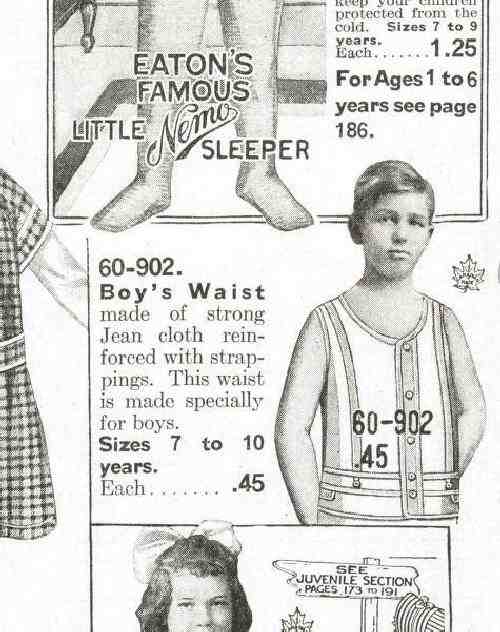
Figure 1. Canadian children commonly wore long stockings througout the 1910s. We notice an A.T. Eaton catalog page offering a boy's waist made in jean cloth in the 1918-19 Fall-Winter catalog.


Figure 1. Canadian children commonly wore long stockings througout the 1910s. We notice an A.T. Eaton catalog page offering a boy's waist made in jean cloth in the 1918-19 Fall-Winter catalog. |
Canadian children commonly wore long stockings througout the 1910s. Thus support garments were also offered. A.T. Eatons offered a boy's waist made in jean material made in its 1918-19 Fall-Winter catlog, page 192.
T. Eaton's was a well known Toranto department store. Their catalogs provide a good indication of the styles popular in Canada at the time. This Canadian retailer began publishing mailorder catalogs in 1881, at least that is we begin noticing them. We have catalogs from the 1970s, although we do not know about the company's current status. The 1970s catalgs were full of clothes which look like American styles. Timothy Eaton, founder of the huge all-Canadian department store chain bearing his name, was an Irish immigrant born on a tennant farm in northern Ireland. He was born in 1834 and followed his brothers to Canada in 1854. His brothers had opened a small dty goods store in St. Marys. Timothy Eaton began his business with a small dry goods business in Toronto during 1869. He built a giant retail store in Ontario’s capital city along with a country-wide mail-order business and a big new branch store in Winnipeg, by the time of his death in 1907. The Winnipeg branch was the first of many branches. Eaton Company business establishments eventually spread all across Canada when Timothy’s family
successors extended the Eaton empire. Timothy masterminded the company during the crucial period of its early development, spanning nearly 40 years. It was Timothy who implemented the concept of the "Department Store", in Canada, a concept which were already flourishing in London, Paris, and New York.
The boys and girls wearing long stockings in the second half of the 19th Century held them up with various styles of stocking supporters. I believe that boys did not wear these supporters commonly in the first half of the 19th Century because kneepants were not nearly as common. Boys wearing long trousers did not commonly wear stocking supporters. It was not until the 1870s when kneepants became more commonly worn that stocking supporters became widely worn. Both boys and girls wore them. They were several different styles, including over the shoulder and waist styles. They were not very comfortable especially for boys involved in strenous outdoor activities. Notably Lord Baden Powell when he designed the first Boy Scout uniform chose kneesocks so cumbersome stocking supporters would not be necessary.
We do not have the actual Eaton's page here, only a poor copy imge. At first we thought we couldn't read the text for the stocking supporter models and other support devices shown here in 1918. As in many older catalogs, there is quite a jumble of items. We have been working on it, and we think (by hook or crook) we've now managed it. The problem wasn't quite as bad as we had at first thought.
Canadian children commonly wore long stockings througout the 1910s. Thus support garments were also offered. A.T. Eatons offered a boys waist out in its 1918-19 Fall-Winter catlog, page 192. The Eaton's ad copy reads, " 60-902. Boy's Waist made of Jean cloth reinforced with strapings. This waist is made specially for boys. Sizes 7 to 10 years. Each ........45." Note the little maple leaf symbol that indicates that it was Canadian-made. The actual manufacturer, however, is not indicated.
This is an unusually clear depiction of the typical boys' underwaist in 1918. Variations of this style contnued to be worn by American and Canadian boys up through the middle 1940s. The bone
buttons on either side of the first row are obviously for fastening knee pants or additional underwear such as underpants. These garments were sometimes referred to as "panty waists" by mothers, but boys hated the term so manufacturers tended to avoid it as inimical to sales. The feature that makes this waist specifically for boys is the fact that it buttons down the front and is unadorned by lace or other feminine decoration. Many of the styles for girls were back-buttoned. But many underwaists of the period could be worn by either gender and were advertised as being for both boys and girls. Interestingly, the garter tabs at the sides for fastening hose supporters are not equipped with
pinning tubes (as was often the case during the 1920s, 1930s, and 1940s). It is hard to be sure from the illustration, but the tabs look as though they have metal eyelets for fastening the pins of the
supporters. Note that the upper age is only 10--not 12 as was usually the case with the American underwaists. Boys older than 10 probably wore skeleton garter waists of the Dr. Parker style as a means of holding up long stockings. The boy in the illustration looks as though he is made to look about 9 or 10.
Navigate the Boys' Historical Clothing catalog/magazine pages:
[Return to the Main Canadian mail order 1918 page]
[Return to the Main Canadian mail order 1910s page]
[Main photo/publishing page]
[Store catalogs]
[Fashion magazines]
Navigate the Boys' Historical Clothing Web Site:
[Introduction]
[Activities]
[Biographies]
[Chronology]
[Clothing styles]
[Countries]
[Bibliographies]
[Contributions]
[FAQs]
[French glossary]
[Satellite sites]
[Tools]
[Boys' Clothing Home]
Navigate the Boys' Historical Clothing Web Site:
[Sailor suits]
[Sailor hats]
[Buster Brown suits]
[Eton suits]
[Knickers ]
[Rompers]
[Tunics]
[Smocks]
[Pinafores]
[Long stockings
[Underwear]
